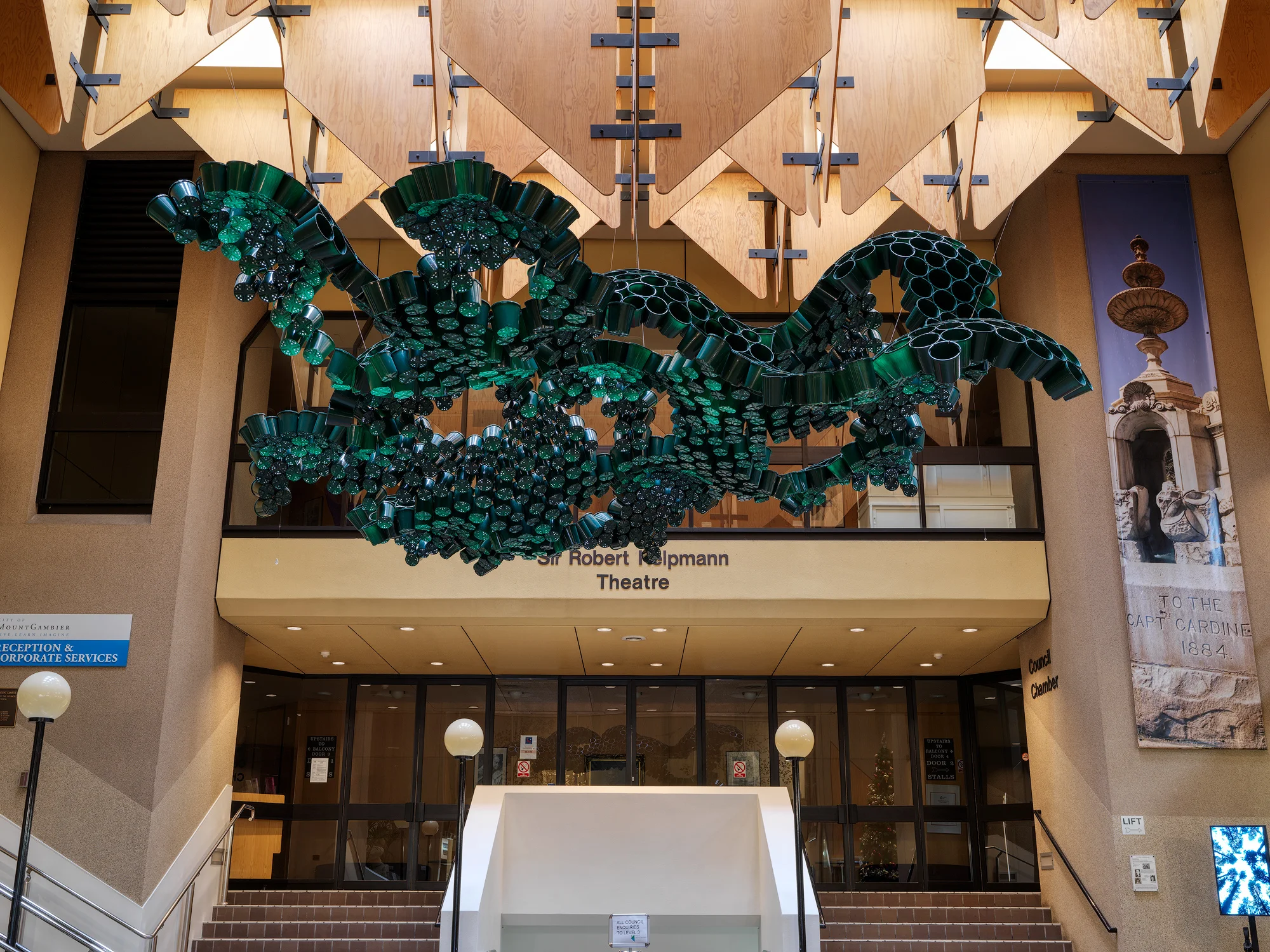I work predominantly in sculpture and installation, creating work in response to my observations of people, objects and materials. I re-present objects, highlighting the vitality I see in them. A repetitive production process allows me the time and space to contemplate the material and work collaboratively with it to activate it in some way. In this case, the green plastic pots were used to replicate the feeling one gets when looking up, encircled by tall limbs in a pine forest. I used 1000 pots to represent the 1000 pine trees planted in each pine plantation in the surrounding districts of Mount Gambier, whilst looming in the background is a constant reminder of our everyday use of plastic. Surely, we can think of another material to plant our seedlings in.
Pine Tree Green
2018
plastic pots, plastic cable ties
photographer Grant Hancock
Space Matters
“We were walking, together and separate, among the brusque detours of the forest.” (Fernando Pessoa, The Book Of Disquiet)
Pine trees grow straight up to the light. Light falls down through the canopy and reaches the ground soft and dappled.
Jane Skeer’s Pine Tree Green consists of one thousand green perforated plastic plant pots tied together and hung under the foyer ceiling of the Sir Robert Helpmann Theatre. It’s not a forest, although it’s come about because of pine forests and time spent looking up through the trees. Pine forests were playgrounds when I was young. I liked to walk on their spongy ground, be in their dim light, and listen to the muffled sounds of the town. These all-at-once tangible and intangible experiences offered by the forest are interdependent, but each is founded by the tree(s).
An artwork has a context, even as it keeps its own counsel; it’s within an arrangement of other materials and forms – in landscape or in architecture (as here), on the ground/floor, on a wall, or high in the air, floating. All built structures begin as lines on paper (sketch, scribble, sentence). Lines connect to other lines, lines cross lines, lines rise and fall; lines serve the creation of space bordered by various substances – room, shop, shed, hotel, bank, theatre, etc. Lines change the meaning of space; ground becomes line, a covered (vanished) surface.
A structure of pots and connectors between floor and ceiling, a configuration of affect(s), is not a ‘picture’ of the thing (forest) itself, as felt, as memorized, but an evocation, an assemblage, relying on space itself, and space around space, and bodies in space (and their memories), and their momentary change of direction as limbs and joints and thoughts shift gear; the neck extends and lifts the head backward, the eyes turn to ‘heaven’, and hesitate. There’s no direct affinity (or resonance) between pots and trees; the pots are themselves, each, and in company, trees are themselves, each, and in company. Pine trees are grown in company that depends on the spacing of plants between lines and within lines; for example, spacing, between and within, of three metres produces a density of 1000-1100 trees per hectare.
A pot carries hope (like a bowl); we bring home a plant in a pot; it’s ‘plastic’ though, a malleable material made of synthetic compounds, mostly petrochemical; plastic causes havoc in the world’s oceans; we dream that ‘plastic’ will find its good recycled use (roads, clothes, yarns). The history of plastic hovers as background to the work, as does the history of forestry with its political, social, and economic influences; these backgrounds make for a ghostly confluence of local and global issues.
The pots have exceeded their own usefulness, their own plentitude and modesty. They have been chosen to do what they couldn’t imagine doing – that is, be an artwork that lets light through their base – which is usually flat on the ground, pressed between soil and earth. The pots are playing the role, theatrically, of the tips of pine trees; together they play themselves (present) as well as something-other (absent), and become strange (therefore) to themselves; they’re playing (strangely) against type. Perfect for a theatre foyer.
The American painter Agnes Martin said her lines were rows of trees. She abstracted trees into horizontal lines (a line painting from 1964 is titled The Tree). Her lines are beautiful careful slow lines that don’t literally represent what is there, in the world, as subject or story. Viewers are given the chance to approach her paintings understanding that one thing is another thing, that disparate entities are fluid and fleeting – a forest, a branch, a leaf; we can see anew, begin again, even for a second.
Lines, shapes, textures, substances, and colours are objective tools, and malleable. They can mass in response to a complex situation or circumstance and emerge through time and labour as a complexity of another kind – sculpture. The field of pots conditions the atmosphere of the space.
Drawn onto paper, lines with holes and curves are transformed by solid matters and often become unsettling in their spatial ‘aliveness’. Edges come into relation with already existing edges and already existing and immovable elements. Pine Tree Green draws attention to the actual height of the foyer space, to the pattern of the wooden panels, to the frosted skylights, to the light fittings, to the angles of the walls, the corners, doors, and steps. A stranger who comes into our midst gives us pause to see what and who we are.
A public artwork is an action that affects the site it occupies; the site though remains as it was, but is, in the mode of change, now more evidentially itself (as if anew). The stranger (art) in the midst of the site shows what and who the site is; the stranger is clearly evident, the site is clearly (more) evident (as are we).
Linda M Walker 2018












